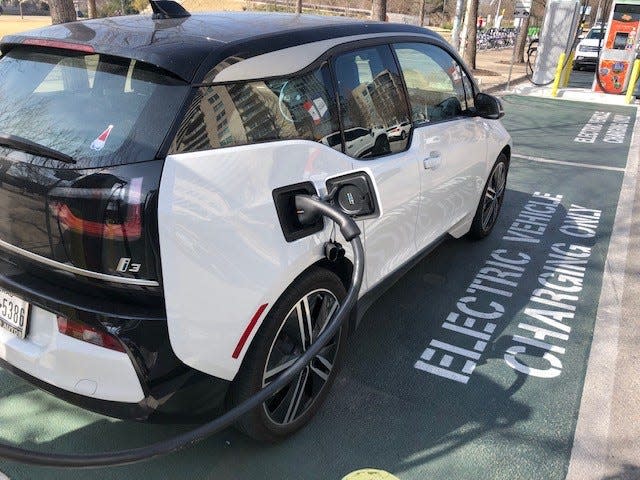Texas is a red state, but one recent event shows it's also a green state
AUSTIN — Texas, which is powering the nation's oil and gas renaissance and is the nation's largest and most reliable red state, has just joined the Green New Deal.
Well, kind of. Sort of. In a way.
On Wednesday, federal regulators gave a thumbs-up on Texas' 81-page plan to spend $408 million from the new infrastructure law to construct hundreds of electric vehicle charging stations across the state, even in the least populated counties.

It's a public-private project that will take several years to complete. And it's one that Tom "Smitty" Smith, a longtime environmental lobbyist and executive director of the Texas Electric Transportation Alliance, called "comprehensive," "impressive" and "a really big deal."
The plan, which was developed by the Texas Department of Transportation and signed off on by the state comptroller's office and the Texas Commission on Environmental Quality, and which contains input from electricity providers, calls for charging stations every 50 miles or so along the major interstate corridors, with a mix of fast-charging and slower-charging outlets. "Fast" in this context means about a half-hour.
"The network will give electric vehicle drivers confidence and flexibility when traveling for work, recreation, or exploration regardless of distance traveled or weather conditions," the plan states.
More:More electric vehicles in Texas? Federal funds for charging stations may bring big changes
According to the U.S. Department of Energy, electric vehicles require less raw energy than their gasoline- or diesel-powered counterparts, even if the electricity consumed is produced from fossil fuels.
The downside is that the production of "the lithium-ion batteries for electric vehicles is more material-intensive than producing traditional combustion engines," according to a study by the Massachusetts Institute of Technology's Climate Portal updated in July. But on balance, the report says, electric vehicles are still more friendly to the environment.
Texas' charging station plan embraces the fact that the state's vehicle fleet is inching away from the internal combustion engine, which for more than a century has powered the nation — and the developed world, for that matter — with crude oil mined and refined in Texas and in other regions.
Using data from the Texas Department of Motor Vehicles, the plan says that more than 134,000 electric vehicles were registered in 233 of the state's 254 counties as of July. That's just shy of 1% of the state's total fleet, but it's more than three times as many as the number riding the highways of Texas in 2020.
"With rapidly growing adoption rates, it is necessary to ensure Texas will be able to meet the demand of these new vehicles on the road," the plan states.
To be fair, as ambitious as the plan is, it's well below the sprint-to-zero-emission goals set by the advocates of the Green New Deal, a notion that's been around for about 15 years but has only recently cemented itself in the public lexicon.
And in Texas, the phrase has been used as a cudgel by conservatives to whomp upside the heads of progressives they see as insufficiently supportive of the state's oil and gas. So effective was that weapon that Democrats in the Texas oil patch were pleading with their national counterparts to shut up already about the Green New Deal during the 2020 campaign cycle.
But political rhetoric and bumper-sticker policy positions aside, Texas' charging station plan clearly illustrates that state leaders understand that oil and gas can't go it alone when it comes to powering the state. If fact, that understanding long predates the rollout of electric vehicles.
More than a dozen years ago, Texas embarked on a $7 billion plan to stretch high-capacity power lines along a network of poles and towers to bring the electricity generated by the West Texas winds to the state's urban centers. Not long after, wind turbines also began springing up like gargantuan dandelions along the Texas Coast.
Texas, long the nation's top oil- and gas-producing state, now cranks out 26% of the country's wind-powered electricity, according to a report just published by the comptroller's office. No other state produces more.
In fact, Texas produces so much wind and solar power, there aren't enough transmission lines to get all of the green-generated juice to the market, according to the report.
There's little doubt that the demand will keep rising, both because of the expected increase in electric vehicles in Texas and for the old staples like air conditioning, TVs, laptops, and household and industrial appliances.
The Electric Reliability Council of Texas forecasts that 1 million electric vehicles will be on the road in Texas within about five years. But it will still be a fraction of the state's fleet, which now stands at about 22 million cars, trucks, minivans and motorcycles.
And all of that means that even a modest embrace of green energy in the form of new charging stations along every highway and within the bounds of every county falls well short of an assault on Texas. At least for the foreseeable future.
John C. Moritz covers Texas government and politics for the USA Today Network in Austin. Contact him at jmoritz@gannett.com and follow him on Twitter @JohnnieMo.
This article originally appeared on Corpus Christi Caller Times: Why electric and gas-powered cars will continue to coexist in Texas

